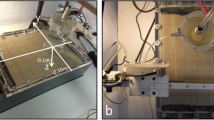Abstract
Backward erosion piping is an important failure mechanism in both dikes and dams where uniform silts and sands are covered by a cohesive layer. It is an internal erosion mechanism during which shallow pipes are formed at the interface of the aquifer and the cohesive top layer in the direction opposite to the flow. The hydraulic conditions near the pipe tip determine the onset of erosion near the pipe tip, which causes pipe lengthening. The seepage field near the pipe tip was analysed using the analytical solutions. The two-dimensional (2D) analytical solution available for calculating the seepage field at the vertical section of the pipe tip in three-dimensional (3D) groundwater flow has been validated on the basis of experiments with 3D configurations. The motion characteristics of particles at the pipe tip were explained on the basis of the analysis of the effect of the ditch at the toe of the pipe tip on the hydraulic conditions near the pipe tip. The equilibrium of the soil in front of the pipe tip was analysed to determine the pressure distribution on the top of the sand layer in front of the pipe tip. The unified method for calculating the local critical hydraulic gradient at the pipe tip in both 2D and 3D experiments was proposed. The local critical hydraulic gradients at the pipe tip were analysed for the available experiments, indicating that the influences of grain diameter and scale on the local critical hydraulic gradient are limited, a finding that is essential for the development of a new model.














Similar content being viewed by others
References
De Wit JM (1984) Onderzoek zandmeevoerende wellen Rapportage Modelproeven. Grondmechanica Delft report CO-220887/10
Ding LQ, Wu MX, Liu CJ, Sun YD, Yao QL (2007) Numerical simulation of dynamic development of piping in two-stratum dike foundations. Water Resour Hydropower Eng 38(2):36–39
Dong ZR (1999) Practical technology of emergency repair of levees. China Water Power Press, Beijing
Hanses UK (1985) Zur Mechanik der Entwicklung von Erosionskanälen in geschichtetem Untergrund unter Stauanlagen. Universitätsbibliothek der TU Berlin
Müllerkirchenbauer H (1980) Zum zeitlichen Verlauf der ruckschreitenden Erosion in geschichtetem Untergrund unter Dammen und Stauanlagen. Schriftenreihe Des Deutschen Verbandes Fur Wasserwirtschaft Und Kulturbau
Miesel D (1978) Rückschreitende Erosion unter bindiger Deckschicht. Baugrundtagung Berlin
Pietrus TJ (1981) An experimental investigation of hydraulic piping in sand. Master of Science Thisis. University of Florida, Gainesville
Robbins BA, Beek VMV, López-Soto JF, Montalvo-Bartolomei AM, Murphy J (2017) A novel laboratory test for backward erosion piping. Int J Phys Model Geotech 18:266–279
Schmertmann JH (2000) The no-filter factor of safety against piping through sands. Judgm Innovat 111:65–132
Silvis F (1991) Verificatie piping model: proeven in de deltagoot. Grondmechanica Delft, Delft (in Dutch)
Terzaghi K, Peck RB (1967) Soil mechanics in engineering practice. Wiley, New York
Townsend FC, Bloomquist D, Shiau JM, Martinez R, Rubin H (1988) Evaluation of filter criteria and thickness for migrating piping in sands. Department of Civil Engineering, University of Florida, Gainesville
USACE (1956) Investigation of underseepage and its control: Lower Mississippi River levees. Technical Memorandum No. 3-424, vol 1, Waterways Experiment Station, Vicksburg
Van Beek V, Vandenboer K, Bezuijen A (2014) Influence of sand type on pipe development in small-and medium-scale experiments. In: Cheng L, Draper S, An H (eds) Scour and erosion. Taylor&Francis Group, London, pp 111–120
Van Beek VM (2015) Backward erosion piping: initiation and progression. Doctor of Science Thisis. Delft University of Technology, Delft
van Beek VM, Knoeff H, Sellmeijer H (2011) Observations on the process of backward erosion piping in small-, medium-and full-scale experiments. Eur J Environ Civ Eng 15(8):1115–1137
Van Beek VM, Knoeff HG, Schweckendiek T (2011) Piping: over 100 years of experience—from empiricism towards reliability-based design. Deltares, Delft
Van Beek VM, Koelewijn AR, Kruse GAM, Sellmeijer JB, Barends FBJ (2008) Piping phenomena in heterogeneous sands–experiments and simulations. In: Proceedings of the the 4th international conference on scour and erosion. Japan Google Scholar, Tokyo, pp. 453–459
Van Beek VM, Van Essen HM, Vandenboer K, Bezuijen A (2015) Developments in modelling of backward erosion piping. Geotechnique 65(9):740–754
Van der Zee RA (2011) Influence of sand characteristics on the piping process. Master of Science Thesis. Delft University of Technology, Delft
Vandenboer K, Van Beek V, Bezuijen A (2017) 3D character of backward erosion piping. Geotechnique 68(1):86–90
Yp Xiao, Cao H, Gy Luo (2019) Experimental investigation of the backward erosion mechanism near the pipe tip. Acta Geotech 14(3):767–781
Xiao YP, Cao H, Zhai C (2018) Analytical and experimental investigation of a disturbed zone around a pipe in sand. J Braz Soc Mech Sci Eng 40(4):238
Acknowledgements
This work was supported by the Foshan Self-funded Technology Project (Grant No. 2018AB003651) and the Guangdong Natural Science Foundation (Grant No. 2018A030313383).
Author information
Authors and Affiliations
Corresponding author
Additional information
Publisher's Note
Springer Nature remains neutral with regard to jurisdictional claims in published maps and institutional affiliations.
Rights and permissions
About this article
Cite this article
Xiao, Y., Cao, H., Luo, G. et al. Modelling seepage flow near the pipe tip. Acta Geotech. 15, 1953–1966 (2020). https://doi.org/10.1007/s11440-019-00878-8
Received:
Accepted:
Published:
Issue Date:
DOI: https://doi.org/10.1007/s11440-019-00878-8



